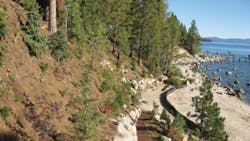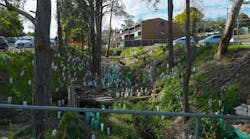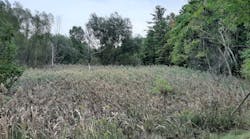Project Profile: From Threadbare to Restored Elegance
This story begins on a high-bank lakefront property in Rubicon Bay, CA, with a dark tangled path meandering its way down the 60-foot-tall, unstable, and badly eroded shoreline bluff face. The site is said to have been originally owned by Scottish immigrant and journalist B.C. Forbes, the founder of Forbes magazine. It is now owned by a London family that splits its time between the US and the UK. Having found and bought its dream property, the family first had to deal with the issue of bluff erosion. Remediation of the bluff soon became the largest and most complex shoreline stabilization and restoration project ever attempted in Lake Tahoe history.
The property sits on approximately 4.8 acres overlooking Rubicon Bay with a vast 180-degree vantage. It is a gently sloping lot that abruptly drops 60 feet down to a wide, gentle, sandy beach on the lake. The entire project involves removing an existing residence and constructing a new single-family home, tennis court, and guesthouse. This requires placement of the main house just behind bluff’s edge in a zone threatened by the unstable bluff face. Bluff stabilization was an immediate and primary goal.
Initial concerns and discussion about the stability of the bluff face were prompted by the owners’ desire to protect the new residence and to preserve the landform with its magnificent panoramic view. There was also a requirement to create a safe and stable walking path down to the private beach. Surface erosion and sloughing of the bluff face appeared to be fairly widespread; furthermore, erosion of the bluff face was likely accelerated by Lake Tahoe undercutting the toe of the bluff during periods of high lake water.
In addition to structural considerations required to accommodate the new walking path and main house, the owners envisioned a masterfully restored façade to recapture the native ecology so admired throughout the High Sierras. The owners’ vision paralleled the strict scenic assessment standards set by the Tahoe Regional Planning Agency (TRPA) and smoothly carried the stabilization project through the agency review process.
Such traditional methods of mechanical slope stabilization as benching, shotcreting, or retaining wall construction would have been effective at stabilizing the bluff face. Those approaches, however, would have substantially altered the appearance of the shoreline and would have been quickly rejected by the TRPA and adjacent property owners.
The sandy silt bluff material coupled with the semi-arid Lake Tahoe environment was not an ideal restoration combination. After considerable thought and consultation with erosion control vendors and consultants, it was decided that a hybrid biotechnical solution would be required: a smorgasbord of stabilization recipes. The combination included about 500 Launched Soil Nails, more than 10,000 square feet of Galfan-coated SuperMesh, more than 10,000 square feet of custom vegetated CellScape coir cellular confinement, and more than 400 tons of 2-foot- to 6-foot-diameter native granite. The Launched Soil Nails, installed at up to 200 miles per hour with a declassified British air cannon, provided slope stability and an anchorage point for the SuperMesh.
The biotechnical surface treatment employed native granite boulders and thousands of plants. More than 10,000 square feet of CellScape coir cellular confinement was hand-packed with a custom soil blend, then vegetated with plants and seed. A broad range of plant materials, from grass and forbs to shrubs and trees native to the regional watershed, were selected to achieve maximum root anchorage and foliage cover.
Boulders were placed within closely spaced arrays of Launched Soil Nails at various heights to complement the boulders at the toe of slope and path, creating a random, natural appearance. Lateral low-volume drip lines were placed throughout the facing and are required only to help establish the native plant species.
One of the owners commented on the finished project: “I am delighted with the results, and I trust TRPA will be also, as they represent a first-class restoration of the badly eroded, messy, and dangerous bluff that was there previously.” And a member of the TRPA environmental compliance team, Ethan Casaday, noted, “This is the best slope stabilization I have seen in my 20-plus years doing erosion control work. Very impressive!”
Many people and companies worked diligently together to raise the bar for future shoreline and stabilization projects in the Tahoe basin: the project specialty slope stabilization and design-build prime contractor, Landslide Solutions Inc.; landscape design and contractor, Native Plant Farms and Tree Movers; civil and rock placement contractor, Manchester Enterprises Inc.; geotechnical consultants, Holdrege and Kull; the project engineer, John S. Black Consulting; the permit specialist, Jan Brisco; the architect, Faulkner Architects; and the property owners.


